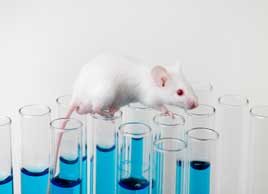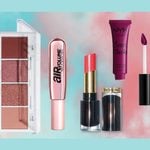The truth about animal testing
The beauty industry has been moving away from using animals to test the toxicity of products. Here’s the latest on Canada’s progress, and how to understand what a "cruelty-free" label really means

Source: Best Health Magazine, September 2011
Since at least the 1960s, animal testing has been a routine step in getting shampoos, lipsticks, mascaras, hand lotions and many other personal products onto store shelves. There is no specific law requiring animal testing, but it is the manufacturers’ responsibility to have available data proving that these products are safe for human use. And scientific testing using animals has long been the accepted method of proving a cosmetic isn’t a hazard to our health.
It may come as a surprise to learn that animal testing was once considered to be the more humane way. After the Nazi-led human experimentation in World War II, two sets of ethical research principles’the Nuremberg Code developed following the post-war military tribunals, and the Declaration of Helsinki by the France-based World Medical Association, an international doctors’ organization’recommended that drugs and chemicals be tested on lab animals before they could be used by humans. ‘[It was] to ensure that there was no testing on vulnerable populations of humans,’ says physiologist Gilly Griffin at the Canadian Council on Animal Care (CCAC) in Ottawa.
The Declaration of Helsinki has subsequently been modified so that it is no longer a requirement to test on animals first. But ‘many companies worldwide had already adopted these principles. The cosmetics industry was still reeling from a 1933 scandal that saw more than a dozen American women horrifically blinded by an eyebrow dye called Lash Lure. One person even died from infection.
In the decades since, the cosmetics industry around the world has relied on rats, mice, guinea pigs, rabbits and other animals to test for toxicity.
What testing is done?
Obviously, many consumers are uncomfortable with the practice. Using animals to prove a cosmetic is harmless can be cruel and painful. One typical test to evaluate a surfactant, emulsifier or other ingredient involves dripping the substance into the eye of an animal, usually a rabbit, and assessing if there’s any eye injury. For a skin irritancy test, the substance is rubbed onto, or scraped into, a shaved patch of skin to find out if the tissue gets inflamed from contact. These are called Draize tests.
‘It’s very upsetting to think of those tests being done,’ says Lori Waller, communications coordinator at the Canadian Federation of Humane Societies in Ottawa. ‘It just doesn’t seem justified to make animals suffer simply to develop a cosmetic product.’
Alternatives to animal testing of cosmetics have been in development since the 1960s. Virginia-based People for the Ethical Treatment of Animals (PETA) has been negotiating with the U.S. government since the late 1990s to reduce toxicity testing on animals, which it says ‘could easily be replaced with more sophisticated, more accurate and less expensive non-animal alternatives.’ And the concepts of ‘cruelty-free’ and ‘not tested on animals’ have become an integral component of the green beauty movement.
There are new alternatives
Today, artificial skin or corneas made from human cells can be used to test for skin and eye irritation. Cell cultures from mammals can test whether a substance causes can’cer. (These are known as ‘in vitro’ studies because they don’t involve the use of a live animal.) Population health studies and sophisticated computer models can also help cosmetics scientists predict individual reactions or toxicity.
Besides rising consumer demand, though, there are other reasons behind the shift to new science when it comes to cosmetic product testing. ‘Animal tests are too slow and too expensive, and they may not be the most relevant tests that can be done because they are not done on humans,’ says Daniel Krewski, director of the McLaughlin Centre for Population Health Risk Assessment at the University of Ottawa.
Other experts agree. The Johns Hopkins Center for Alternatives to Animal Testing in Baltimore has published articles pointing out the superior speed and accuracy of many newly developed non-animal tests.
More good news
We asked two of the world’s largest cosmetics companies about this issue, since many of the toxicologists who are developing animal-free test methods are employed in the industry.
Procter & Gamble (the company behind many brands, including CoverGirl, Olay and Pantene) has pumped more than US$275 million into research and development of alternatives to replace animal testing for irritancy, absorption and toxicity. Today, says Pam Baillie, external relations manager for beauty and grooming, more than 99 percent of its safety evaluations do not involve animals.
L’Oréal (which owns brands including Vichy, Lancôme, Garnier, Biotherm and L’Oréal Paris), too, says that today more than 99 percent of its raw ingredients, and since 1989 all of its final products, are tested without animals. ‘This was really a major decision on the part of L’Oréal,’ explains Patricia Pineau, director of scientific communications with the company’s research department in Paris. ‘Beauty cannot be linked to pain.’ She says the company is convinced that human reconstructed skin and toxicology software provide more relevant test results than animal skin.
Lab animals are still needed for ingredient safety evaluations based on international regulations, particularly systemic reactions involving multiple bodily systems or organs, like allergies or reproductive toxicity. ‘There is no compromise with safety,’ Pineau says. ‘Consumers need to be able to wash their hands or apply sunscreen without being exposed to any safety issues. This is our trust pact with them. After our 25 years of research and investment in predictive methods, we are on the point of being able to abandon animal testing.‘
The role of government
Moving to new methods also depends on those methods being accepted by government regulators. Says Darren Praznik, president and CEO of the Canadian Cosmetic, Toiletry and Fragrance Association: ‘There has been quite a movement in the world to eventually do away with testing on animals, for very good reasons. I don’t think you’d find anyone who opposes it on principle.’
The key, Praznik says, is that ‘whatever ends up being developed has to meet the regulatory standards in whatever jurisdictions it is being sold in.’
That’s where things get tricky. Today’s cosmetics industry is multinational: A product might be manufactured in one country and then sold in many others. So companies have to keep pace with international regulations. ‘When they’re making those products, they will always meet the highest standards,’ says Praznik. Although most countries do not specifically require animal testing, just as Canada doesn’t, they do require that a product be safe, which often necessitates an animal test.
As of 2009, the European Union has outlawed many types of animal tests in cosmetic production, and the practice may be completely prohibited by 2013. No products tested on animals will be marketed inside the EU, even if they’re manufactured elsewhere. In the U.S., individual states including California, New York and New Jersey have banned the use of animals in cosmetic testing where validated alternatives exist. (Validation’which means proving that a new testing method is accurate and reliable’is a necessary step when replacing standard methods.)
Here, Health Canada maintains that we are still not ready to do away with animal testing, and the department hasn’t passed anything that approaches a ban of it on cosmetics that are manufactured or sold in Canada. ‘Advancements in science have not yet progressed to the point where animal testing is completely avoidable,’ says Health Canada media relations officer Olivia Caron.
Health Canada does point out that ‘the use of laboratory animals in toxicity testing for cosmetic- and human health’related product testing has been reduced significantly due to advancements in science.’ It’s not known exactly how many animals are used in Canada in regulatory testing of personal cosmetics.
Two years ago, Health Canada signed ‘an international agreement with Japan, the U.S. and the EU to collaborate on validating animal-free methods of toxicity testing for cosmetics and all other products that pose risks to humans or the environment.
The three Rs of ethics
‘The internationally recognized ethic of animal testing has always been that animals should be used only when there’s no other way,’ says Griffin at the CCAC. The federally funded agency regulates the ethical use and care of animals used in science in Canada: how they should be housed, transported, handled and even euthanized. All university and government labs follow these guidelines, as do private labs that work for the government, or are producing safety data to meet government regulations, or simply want credibility.
The CCAC, like many animal-rights groups, promotes the ‘three Rs’ of animals in research: replacement, reduction and refinement (to reduce pain and suffering). ‘The replacement of animals with alternative testing is a priority for us,’ says Griffin. To that end, the council keeps a public database of non-animal testing methods as they’re developed, including information about their endorsement or validation by international bodies like the Organisation for Economic Co-operation and Development.
It’s impossible to guess when Health Canada will fully ban animal testing on cosmetics. But at least alternatives are coming to the fore, and the cosmetics world seems to be moving ahead. And if there’s one thing all sectors agree on, it’s that the new face of toxicity testing shouldn’t, in fact, have a face.
This article was originally titled "Animal testing under the microscope" in the September 2011 issue of Best Health. Subscribe today to get the full Best Health experience’and never miss an issue!




